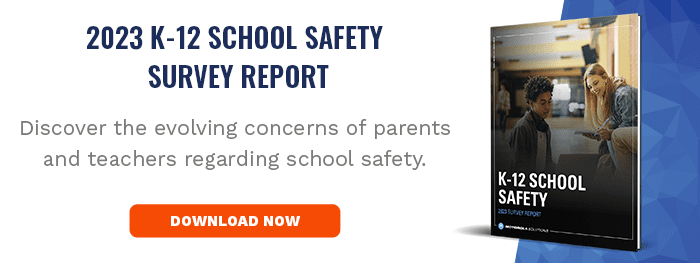New Motorola Solutions Report Asks and Answers Questions about School Safety
Nearly 50 million students and 3 million teachers will head back to K-12 schools all over the U.S. this month or just after Labor Day. It is an annual rite of passage that is typically met with mixed emotions. School age children, educators and parents tend to feel both sad about summer ending and excited for new milestones but in recent years they have added yet another consideration into the mix: anxiety over safety issues. With 23 school shootings causing injuries or death in the first six months of the year and bullying on the rise, is it any wonder that members of the K-12 school community are apprehensive about getting back to reading, writing and arithmetic?
To better understand sentiments about school safety, Motorola Solutions surveyed 1,000 K-12 educators and 1,000 K-12 parents across the nation in advance of the new academic year. Those closest to the issue were asked about their greatest safety concerns, emergency preparedness protocols, communication methods, the technologies in place and training. The overarching takeaway from the 2023 K-12 School Safety Report? Parents and educators alike are more concerned about school safety now than they were five years ago (67% of both groups).
How are parents feeling?
Sixty-six percent of parents and 72% of teachers say that safety is a major factor in choosing a school to send children to or to teach at. The good news is both groups have confidence in their school emergency preparedness and response plans. Even still, parents are nervous about bullying/cyberbullying (67%), active shooters (56%) and student mental health (55%), while teachers rank student mental health (72%), adequate staff to keep schools safe (56%) and bullying/cyberbullying and faculty/staff mental health (55% each) as their biggest worries.
What kind of communication channels are being used?
Whenever possible, schools should try to get ahead of school safety issues. To this end, the research shows that 43% of parents are able to submit anonymous or confidential tips to school officials, public safety authorities or both via an online portal/website (43%), a hotline (38%) or through SMS text messages (36%) but nearly half the teachers surveyed say they are unable to submit such tips. Alert notifications like those provided by Rave Mobile Safety are also essential and should factor in a multitude of modalities so that people are informed about emergencies via their preferred channels. When emergencies do occur, 89% of parents say communication is swift and that their child’s school has an alerting system that contacts them via phone, text and/or email. Eighty-four percent of teachers say that they are notified and given instructions if an emergency is happening on or near campus. More than half the educators surveyed report that they will use the classroom phone to call the main office if there is an emergency. This approach may have made sense in years gone by, but today we know the importance of looping in district officials, 9-1-1 call takers and first responders all at once to expedite response.
Which safety technologies are being used?
More than half of parents (54%) say that they have not seen new safety technologies implemented at their child’s K-12 school while 71% of teachers say that their school has ushered in new safety technology in the last two years. Given today’s rich school safety grant funding environment and legislation for increased security measures, we may see greater awareness going forward. Afterall, safety tech plays an important part in detecting, reporting and communicating concerning behavior. Parents report that their child’s school uses video security equipment, visitor management protocols, access control equipment, alert notifications, two-way radios and public address systems for safety purposes. Forty-six percent of these caretakers would also welcome the deployment of a panic button app like Rave’s Panic Button that allows teachers and staff to directly and swiftly notify 9-1-1.
Where do schools stand on training?
Eighty-nine percent of parents report that their child has participated in a school lockdown drill, while 96% teachers say that they have participated in such training. The majority of parents say their child’s school has conducted active shooter preparedness training too. Nearly three-quarters of teachers have been involved in this kind of drill with students, and an additional 10% have partaken without students. More than half of teachers have engaged with first responders during training; thirty-six percent more would like to engage with these officials but haven’t to date.
Who can learn from these findings?
Whether you’re a parent, teacher, school personnel or public safety professional – these findings can help to stimulate observations and conversations. School safety best practices call for parents to be walked through emergency preparedness plans, response protocols and notification processes at different intervals in the year. Likewise, teachers and staff should be made aware throughout the school year about technology, training and resources that are in place for their benefit and the benefit of their students. Knowledge about the strategies and solutions in place can help to ease the concerns of both K-12 parents and teachers and will ultimately ensure that the 2023-2024 school year is as safe as possible for all involved.





